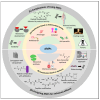Antimicrobial Peptides: A Promising Solution to the Rising Threat of Antibiotic Resistance
- PMID: 39771521
- PMCID: PMC11728462
- DOI: 10.3390/pharmaceutics16121542
Antimicrobial Peptides: A Promising Solution to the Rising Threat of Antibiotic Resistance
Abstract
The demand for developing novel antimicrobial drugs has increased due to the rapid appearance and global spread of antibiotic resistance. Antimicrobial peptides (AMPs) offer distinct advantages over traditional antibiotics, such as broad-range efficacy, a delayed evolution of resistance, and the capacity to enhance human immunity. AMPs are being developed as potential medicines, and current computational and experimental tools aim to facilitate their preclinical and clinical development. Structural and functional constraints as well as a more stringent regulatory framework have impeded clinical translation of AMPs as possible therapeutic agents. Although around four thousand AMPs have been identified so far, there are some limitations of using these AMPs in clinical trials due to their safety in the host and sometimes limitations in the biosynthesis or chemical synthesis of some AMPs. Overcoming these obstacles may help to open a new era of AMPs to combat superbugs without using synthetic antibiotics. This review describes the classification, mechanisms of action and immune modulation, advantages, difficulties, and opportunities of using AMPs against multidrug-resistant pathogens and highlights the need and priorities for creating targeted development strategies that take into account the most cutting-edge tools currently available. It also describes the barriers to using these AMPs in clinical trials.
Keywords: microorganisms; multi-drug resistance; peptide antibiotics; peptide design; therapeutics.
Conflict of interest statement
The authors declare no conflicts of interest.
Figures






Similar articles
-
Advancements in peptide-based antimicrobials: A possible option for emerging drug-resistant infections.Adv Colloid Interface Sci. 2024 Nov;333:103282. doi: 10.1016/j.cis.2024.103282. Epub 2024 Sep 6. Adv Colloid Interface Sci. 2024. PMID: 39276418 Review.
-
Antimicrobial peptides: evolving soldiers in the battle against drug-resistant superbugs.Mol Biol Rep. 2025 Apr 28;52(1):432. doi: 10.1007/s11033-025-10533-z. Mol Biol Rep. 2025. PMID: 40293554 Review.
-
In pursuit of next-generation therapeutics: Antimicrobial peptides against superbugs, their sources, mechanism of action, nanotechnology-based delivery, and clinical applications.Int J Biol Macromol. 2022 Oct 1;218:135-156. doi: 10.1016/j.ijbiomac.2022.07.103. Epub 2022 Jul 20. Int J Biol Macromol. 2022. PMID: 35868409 Review.
-
Antimicrobial peptide-based strategies to overcome antimicrobial resistance.Arch Microbiol. 2024 Sep 23;206(10):411. doi: 10.1007/s00203-024-04133-x. Arch Microbiol. 2024. PMID: 39311963 Review.
-
Antimicrobial peptides: a promising frontier to combat antibiotic resistant pathogens.Ann Med Surg (Lond). 2025 Mar 27;87(4):2118-2132. doi: 10.1097/MS9.0000000000003106. eCollection 2025 Apr. Ann Med Surg (Lond). 2025. PMID: 40212220 Free PMC article. Review.
Cited by
-
Antimicrobial and anti-inflammatory effects of antimicrobial peptide Lf-KR against carbapenem-resistant Escherichia coli.BMC Microbiol. 2025 Mar 31;25(1):183. doi: 10.1186/s12866-025-03906-8. BMC Microbiol. 2025. PMID: 40165061 Free PMC article.
-
In Vitro Antimicrobial Activity of the Novel Antimicrobial Peptide OMN51 Against Multi-Drug-Resistant Pseudomonas aeruginosa Isolated from People with Cystic Fibrosis.J Clin Med. 2025 Jul 23;14(15):5208. doi: 10.3390/jcm14155208. J Clin Med. 2025. PMID: 40806829 Free PMC article.
-
Exploring the Immunological Role of the Microbial Composition of the Appendix and the Associated Risks of Appendectomies.J Pers Med. 2025 Mar 14;15(3):112. doi: 10.3390/jpm15030112. J Pers Med. 2025. PMID: 40137428 Free PMC article. Review.
-
Application of Antimicrobial Peptides (AMPs) in Treatment of Osteomyelitis in Human and Veterinary Orthopedics.J Funct Biomater. 2025 Mar 5;16(3):90. doi: 10.3390/jfb16030090. J Funct Biomater. 2025. PMID: 40137369 Free PMC article. Review.
-
Antimicrobial peptide biological activity, delivery systems and clinical translation status and challenges.J Transl Med. 2025 Mar 7;23(1):292. doi: 10.1186/s12967-025-06321-9. J Transl Med. 2025. PMID: 40055730 Free PMC article. Review.
References
-
- Debnath T., Bhowmik S., Islam T., Chowdhury M.M.H. Presence of Multidrug-Resistant Bacteria on Mobile Phones of Healthcare Workers Accelerates the Spread of Nosocomial Infection and Regarded as a Threat to Public Health in Bangladesh. J. Microsc. Ultrastruct. 2018;6:165. doi: 10.1016/j.jmau.2017.09.004. - DOI - PMC - PubMed
-
- Sagor M.S., Hossain M.S., Islam T., Mahmud M.A., Miah M.S., Karim M.R., Giasuddin M., Samad M.A. Phenotypic and Genotypic Antibiotic Resistance and Virulence Profiling of Enterococcus faecalis Isolated from Poultry at Two Major Districts in Bangladesh. Pak. Vet. J. 2022;42:153–160.
-
- Sultana A., Saha O., Rahman Sid A., Saha A., Hussain M.S., Islam T. Molecular Detection of Multidrug Resistance Pathogenic Bacteria from Protective Materials Used By Healthcare Workers (HCW); Bangladesh Scenario. J. Appl. Sci. 2018;18:48–55. doi: 10.3923/jas.2018.48.55. - DOI
-
- Islam T., Saha O., Sultana S., Hridoy M., Hasan M., Marzan S., Musfiqur Rahman M. Comparison between Reduced Susceptibility to Disinfectants and Multidrug Resistance among Hospital Isolates of Pseudomonas aeruginosa and Staphylococcus aureus in Bangladesh. Bagcilar Med. Bull. 2017;2:88–97. doi: 10.5350/BMB20170828103017. - DOI
Publication types
LinkOut - more resources
Full Text Sources

